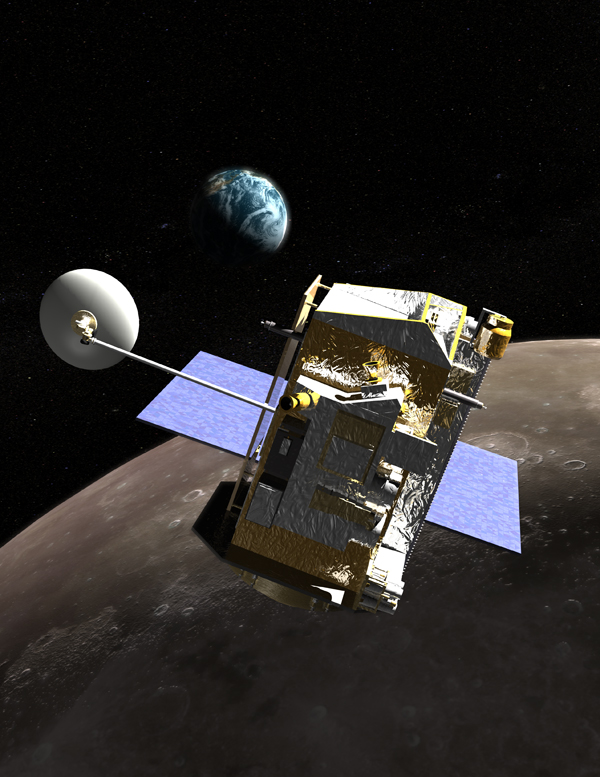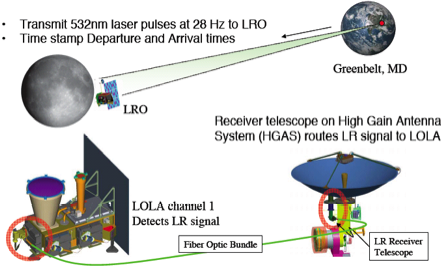
LRO-LR
Jump to: Mission Objectives, Mission Instrumentation, Mission Parameters, Additional Information
Mission Photos:

Courtesy of NASA GSFC
Mission Objectives:
The Lunar Reconnaissance Orbiter (LRO) is the first mission of the Robotic Lunar Exploration Program (RLEP). The LRO mission objective is to conduct investigations that will be specifically targeted to prepare for and support future human exploration of the Moon. Shown above is an artist's conception of the LRO spacecraft in orbit about the Moon. The LR telescope will be located on the High Gain Antenna (HGA) to receive the one-way laser pulses from the terrestrial ground stations.
This mission is currently scheduled to launch in October 2008 and is planned to take measurements of the Moon for at least one year. The measurement investigations are:
- Characterization of deep space radiation in Lunar orbit
- Geodetic global topography
- High spatial resolution hydrogen mapping
- Temperature mapping in polar shadowed regions
- Imaging of surface in permanently shadowed regions Identification of near-surface water ice in polar cold traps
- Assessment of features for landing sites
- Characterization of polar region lighting environment
The LRO Laser Ranging (LR) system makes one-way range measurements via laser pulse time-of-flight from Earth to LRO to determine LRO position at sub-meter level with respect to Earth and the center of the Moon (on the lunar near-side or whenever possible). The LR aspect of the mission allows for the determination of a more precise orbit than possible with S-band tracking data alone. To improve the orbital position of LRO, and meet the Level 1 requirements for data products some improvement to the lunar gravity field is needed.
The LRO-LR system consists of a flight system and a ground system. The flight system consists of a receiver telescope which captures the uplinked laser signal and a fiber optic cable which routes it to the LOLA instrument. The LOLA instrument captures the time of the laser signal, records that information and provides it to the onboard LRO data system for storage and/or transmittal to the ground through the RF link.

The schematic of the laser ranging (LR) concept for LRO is shown in the figure above. The laser ranging data to the LOLA instrument on board LRO will provide relative range measurements to the spacecraft at <10cm precision, 1 Hz. These data will allow scientists to produce a gravity model with sufficient accuracy to calculate knowledge of spacecraft position to within 50 m along track, 50 m cross track, and 1 m radial. This calculation requires S-band tracking data, LR range data, and LOLA science data. SLR stations will transmit 28 Hz 532nm laser pulses to LRO; the time stamp departure and arrival times will be used to calculate ranges to the spacecraft.
Mission Instrumentation:
LRO will have the following on-board instrumentation:
- Laser altimeter (LOLA)
- Camera (LROC)
- Lyman alpha telescope (LAMP)
- Neutron detector (LEND)
- Thermal radiometer (DIVINER)
- Cosmic ray detector (CRATER)
- Radar technology demonstration (mini-RF)
Mission Parameters:
| Sponsor: | NASA |
| Expected Life: | 1 year |
| Primary Applications: | Conduct lunar investigations to support future human exploration of the moon |
| Primary SLR Applications: | Precision orbit determination |
| COSPAR ID: | 0903101 |
| SIC Code: | 0059 |
| Satellite Catalog (NORAD) Number: | 35315 |
| Launch Date: | June 17 2009 |
| NP Bin Size: | 5 seconds |
| Reflectors: | One-way transponder experiment; no return light from spacecraft |
| RRA Diameter: | N/A |
| RRA Shape: | N/A |
| Orbit: | Polar (lunar) |
| Orbital Period: | ~2 hours |
| Inclination: | ~90 deg, with respect to the lunar equator |
| Eccentricity: | Near-circular; eccentricity is bounded and controlled by station-keeping |
| Altitude: | Near-circular, ~50 km (lunar) |
| Weight: | 100 kg |
Additional Information:
Web sites:
- LRO-LR Support site
- NASA
- NASA Space Exploration Program
- NASA GSFC
Publications/Presentations:
- D. Smith, M. Zuber, M. Torrence, J. McGarry, M. Pearlman, Laser Ranging to the Lunar Reconnaissance Orbiter (LRO) at 15th International Workshop on Laser Ranging, October 2006
- J. McGarry, LRO-LR Ground System Requirements at 15th International Workshop on Laser Ranging, October 2006
- J. McGarry, Internal Transponder Data Format (ITDF) at 15th International Workshop on Laser Ranging, October 2006
- Hersmonceux support of LRO-LR in NERC's Planet Earth Online




